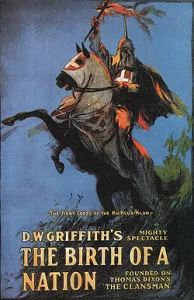A Troubling Masterpiece: How 'The Birth of a Nation' (1915) Forged Cinema's Future While Echoing America's Darkest Past!
The Birth of a Nation
(USA, 1915, D.W. Griffith, 191 minutes)
In the nascent, experimental dawn of American cinema, D.W. Griffith stood as a towering figure, a visionary director who, more than any other, pioneered the very language of cinematic storytelling. His ambition was boundless, his innovation undeniable. The Birth of a Nation (1915) is not merely a film; it is a monumental, undeniably groundbreaking, and profoundly controversial work that shattered existing notions of what cinema could achieve. It was the first true American blockbuster, a technical and artistic triumph that revolutionized narrative filmmaking with its complex storylines, epic battle sequences, advanced editing techniques (like cross-cutting and close-ups), and dramatic use of tinting. Its unprecedented length and scale cemented Griffith's status as a cinematic genius, proving film's power to manipulate emotion and convey complex historical narratives. Yet, its historical importance is inextricably linked to its deeply offensive and dangerous content, making it one of the most significant, and tragically problematic, films ever made.
The film traces the parallel fates of two families during and after the American Civil War: the Northern Stonemans and the Southern Camerons. What unfolds is a sweeping historical epic, portraying the war's devastation and the subsequent Reconstruction era. While technically brilliant, the film's narrative is a heinous work of racist propaganda, shamelessly glorifying the Ku Klux Klan as heroic saviors of the South from what it portrays as a chaotic, threatening post-war landscape dominated by freed slaves and Northern carpetbaggers. It paints African Americans (often played by white actors in blackface) as ignorant, dangerous, and sexually predatory, justifying the Klan's brutal violence. This vile portrayal sparked massive protests from the NAACP and others, yet it also enjoyed immense commercial success, influencing public opinion and fueling racial tensions across the nation. The Birth of a Nation thus stands as a complex, contradictory artifact: a technical marvel that invented much of modern cinema, yet simultaneously a deeply racist cultural stain that used that power for abhorrent purposes.
Director: D.W. Griffith.
Cast: Lillian Gish as Elsie Stoneman, Mae Marsh as Flora Cameron, Henry B. Walthall as Col. Ben Cameron, Ralph Lewis as Austin Stoneman, and Walter Long as Gus.
Special Info/Trivia: The Birth of a Nation was the first American feature-length film (over 3 hours long). It was a massive commercial success for its time, grossing millions. The film was highly controversial for its explicit racism and glorification of the Ku Klux Klan, sparking protests and riots nationwide. It was the first film ever screened in the White House, for President Woodrow Wilson. Griffith pioneered numerous cinematic techniques, including cross-cutting, close-ups, parallel editing, and advanced camera movements, many of which are still used today. It was based on Thomas Dixon Jr.'s novels The Clansman and The Leopard's Spots.

